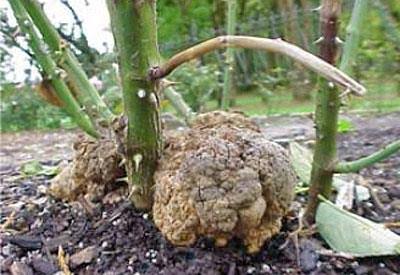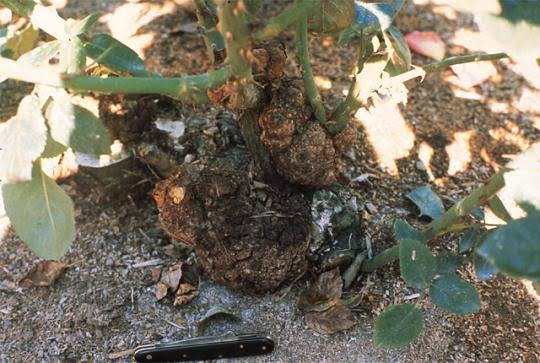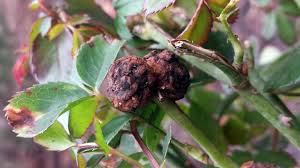Crown Gall: Description, Damages Caused, Control and Preventive Measures
Crown gall, scientifically known as Agrobacterium tumefaciens, is a plant disease that affects a variety of woody and herbaceous plants. This condition is caused by a bacterium that induces the formation of abnormal growths or galls on the plant’s crown, roots, or stems. These galls, often resembling tumors, can hinder the plant’s normal development and impact its overall health.
The bacterium responsible for crown gall, Agrobacterium tumefaciens, possesses a unique ability to transfer a segment of its genetic material, known as T-DNA, into the plant’s cells. This transfer triggers the uncontrolled growth of cells, leading to the formation of galls. It’s like the bacterium hijacks the plant’s genetic machinery for its own benefit.
Affected plants exhibit a range of symptoms, including the appearance of swollen, tumor-like growths near the soil line or on roots. These galls can vary in size and shape, disrupting the plant’s vascular system and nutrient transport. As a result, the infected plant may show signs of stunted growth, yellowing of leaves, and a general decline in vigor.
The bacterium causing crown gall primarily gains access to plants through wounds, such as pruning cuts, grafting sites, or injuries caused by insects. Once inside the plant, Agrobacterium tumefaciens initiates its genetic manipulation, leading to the formation of galls over time.
Efforts to manage crown gall often involve preventive measures, such as maintaining proper plant hygiene to minimize wounds and using disease-free planting material. However, once a plant is infected, control becomes challenging. Removal of affected plant parts, such as pruning galls, may help in some cases, but it does not guarantee complete eradication of the disease.
Research into biological control methods and the development of resistant plant varieties are ongoing to find sustainable solutions for managing crown gall. Farmers and horticulturists continue to explore integrated pest management strategies to mitigate the impact of this bacterial disease on crop yields and ornamental plants.
However, crown gall, caused by Agrobacterium tumefaciens, poses a significant challenge to the health of various plants. Understanding the molecular mechanisms behind this disease and implementing effective management practices are crucial steps in safeguarding agricultural and horticultural crops from the detrimental effects of crown gall.
Read Also: Economic Importance and Uses of Hen Eggs
Plants Affected by Crown Gall (Agrobacterium tumefaciens)

Crown gall can affect a wide range of plants, both woody and herbaceous. Fruit trees, ornamental shrubs, and grapevines are commonly impacted by this bacterial disease. Among the affected plants are popular species like apple (Malus domestica), cherry (Prunus avium), peach (Prunus persica), and plum (Prunus domestica), which are susceptible to crown gall, especially when wounds are present.
In addition to fruit trees, ornamental plants such as roses (Rosa spp.), euonymus (Euonymus spp.), and hydrangeas (Hydrangea spp.) are also vulnerable to Agrobacterium tumefaciens infection. These plants, prized for their aesthetic value, may experience deformities and reduced vitality when afflicted by crown gall.
Moreover, grapevines (Vitis vinifera), essential for wine production, can be adversely affected by crown gall. The disease can compromise grapevine health, impacting both the yield and quality of grapes.
The broad spectrum of plants susceptible to crown gall emphasizes the importance of preventive measures, including proper plant care, minimizing wounds, and using disease-resistant varieties when available. Despite ongoing research and control efforts, managing crown gall remains a significant challenge in various agricultural and horticultural settings.
Damages Caused by Crown Gall

Crown gall can cause significant damage to affected plants, impacting their growth, development, and overall productivity. The damages arise from the formation of abnormal growths or galls induced by the bacterium Agrobacterium tumefaciens. Here are some key consequences of crown gall:
1. Reduced Growth: The presence of galls disrupts the normal growth patterns of plants. As these tumor-like structures develop, they interfere with the plant’s vascular system, restricting the flow of water, nutrients, and hormones. This disruption often leads to stunted growth and diminished overall vigor.
2. Deformed Plant Structures: Galls can manifest at the crown, roots, or stems of plants, causing deformities in these structures. This deformity can affect the appearance and functionality of the plant, making it less aesthetically pleasing and less capable of carrying out essential physiological functions.
3. Decreased Yield: For fruit-bearing plants like apples, peaches, and grapes, crown gall can result in reduced fruit yield and quality. The galls compromise the normal development of fruits, affecting their size, color, and taste. This has economic implications for farmers and can impact the availability of these crops for consumers.
4. Weakened Resistance to Other Stresses: Plants affected by crown gall become more susceptible to other environmental stresses, such as drought, extreme temperatures, and other diseases. The compromised health of the plant makes it less resilient to external pressures, further exacerbating the overall damage.
5. Loss of Ornamental Value: Ornamental plants, like roses and hydrangeas, can lose their aesthetic appeal when infected with crown gall. The presence of galls disrupts the natural form and beauty of these plants, diminishing their ornamental value in landscaping and gardens.
6. Economic Impact: In agricultural settings, the economic impact of crown gall can be substantial. Reduced crop yields, increased management costs, and the potential need for replanting contribute to financial losses for farmers and growers.
Efforts to minimize the damages caused by crown gall often involve implementing preventive measures, such as maintaining proper plant hygiene, avoiding unnecessary wounds, and using disease-resistant plant varieties. Despite these efforts, managing the disease remains a persistent challenge in various agricultural and horticultural contexts.
Read Also: Bacterial Leaf Spot: Description, Damages Caused, Control and Preventive Measures
Control and Preventive Measures

Controlling and preventing crown gall involves a combination of practices aimed at minimizing the risk of Agrobacterium tumefaciens infection and managing affected plants. Here are some key control and preventive measures:
1. Sanitation Practices: Maintain good plant hygiene by regularly cleaning and sanitizing pruning tools and equipment. This helps prevent the transmission of the bacterium from one plant to another through contaminated tools.
2. Minimize Wounds: Since crown gall often enters plants through wounds, minimizing injuries to plants is crucial. Careful pruning, avoiding unnecessary cutting, and handling plants with care can reduce the risk of bacterial entry.
3. Use Disease-Free Planting Material: Start with healthy and disease-free planting material. Select plants from reputable sources and inspect them for any signs of crown gall or other diseases before planting.
4. Avoid Overwatering: Excessive moisture can create conditions conducive to crown gall development. Maintain proper watering practices to prevent waterlogged soil, as this can reduce the likelihood of infection.
5. Crop Rotation: In agricultural settings, practice crop rotation to break the disease cycle. Avoid planting susceptible crops in the same location where crown gall has been identified in previous seasons.
6. Biological Control: Explore biological control methods that involve using beneficial microorganisms to suppress the growth of Agrobacterium tumefaciens. Some naturally occurring soil bacteria and fungi have shown potential in inhibiting the development of crown gall.
7. Resistant Varieties: Planting varieties that are resistant or less susceptible to crown gall can be an effective strategy. Breeding programs have been working on developing plant varieties with increased resistance to this bacterial disease.
8. Early Detection and Removal: Regularly inspect plants for the early signs of crown gall, such as gall formation. Promptly remove and destroy infected plant parts to prevent the spread of the disease within the garden or orchard.
9. Soil Solarization: In some cases, soil solarization—using plastic sheets to trap heat in the soil—may help reduce the population of Agrobacterium tumefaciens in the soil. This method is more applicable in specific climates and may not be universally effective.
10. Chemical Control (Limited): Chemical control options for crown gall are limited, and their effectiveness can vary. Copper-based products may be used, but their application may be more preventive than curative.
Implementing an integrated approach that combines several of these measures is often the most effective strategy for managing crown gall in diverse agricultural and horticultural settings. It’s important to tailor these practices to the specific needs and conditions of the plants and the environment.
Frequently Asked Questions (FAQs) About Crown Gall (Agrobacterium tumefaciens)
1. Q: What is crown gall?
A: Crown gall is a plant disease caused by the bacterium Agrobacterium tumefaciens. It induces the formation of abnormal growths or galls on the crown, roots, or stems of various plants.
2. Q: How does Agrobacterium tumefaciens cause crown gall?
A: The bacterium transfers a segment of its genetic material, known as T-DNA, into plant cells. This genetic manipulation leads to uncontrolled cell growth, resulting in the formation of galls.
3. Q: Which plants are commonly affected by crown gall?
A: Fruit trees such as apples, cherries, and peaches, ornamental plants like roses and hydrangeas, and grapevines are commonly affected by crown gall.
4. Q: What are the symptoms of crown gall?
A: Symptoms include the formation of tumor-like galls near the soil line, on roots, or stems. Infected plants may exhibit stunted growth, yellowing of leaves, and a decline in overall vigor.
5. Q: How does crown gall spread?
A: Crown gall spreads primarily through wounds on plants, such as pruning cuts or injuries caused by insects. The bacterium enters the plant and initiates gall formation.
6. Q: Can crown gall be cured?
A: Complete cure of crown gall is challenging once a plant is infected. Management often involves preventive measures and, in some cases, removing and destroying infected plant parts.
7. Q: How can I prevent crown gall in my garden?
A: Practice good plant hygiene, minimize wounds, use disease-free planting material, and consider planting varieties that are resistant to crown gall. Regular inspection and early removal of infected parts are also essential.
8. Q: Is there a chemical treatment for crown gall?
A: Chemical control options for crown gall are limited, and their effectiveness varies. Copper-based products may be used preventively, but complete eradication is often challenging.
9. Q: Can crown gall affect crops in consecutive seasons?
A: Yes, crown gall can persist in the soil, affecting crops in consecutive seasons. Crop rotation, soil solarization, and other preventive measures help break the disease cycle.
10. Q: Are there ongoing research efforts to manage crown gall?
A: Yes, ongoing research aims to develop biological control methods, resistant plant varieties, and sustainable strategies for managing crown gall in agriculture and horticulture.
Read Also: Meaning of Ultrafiltration and Basic Principles and Processes of Ultrafiltration









